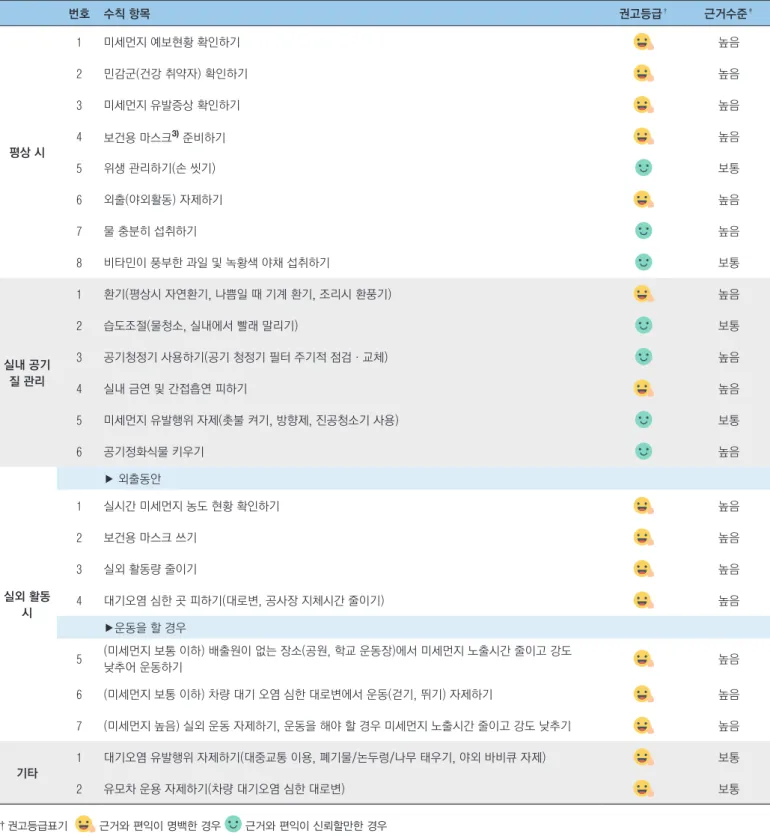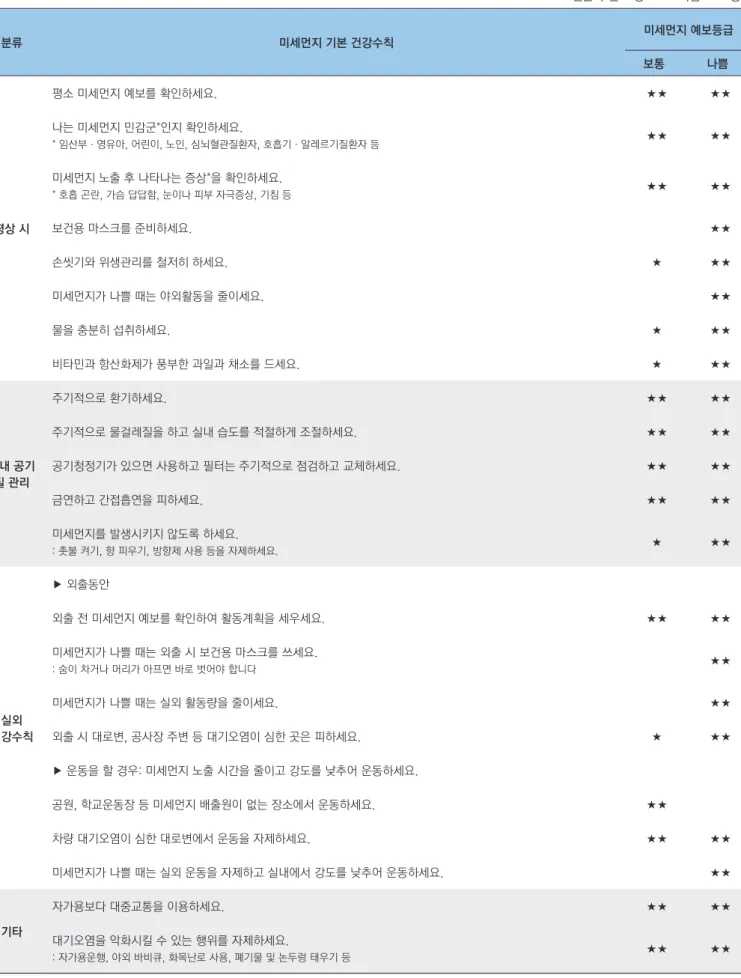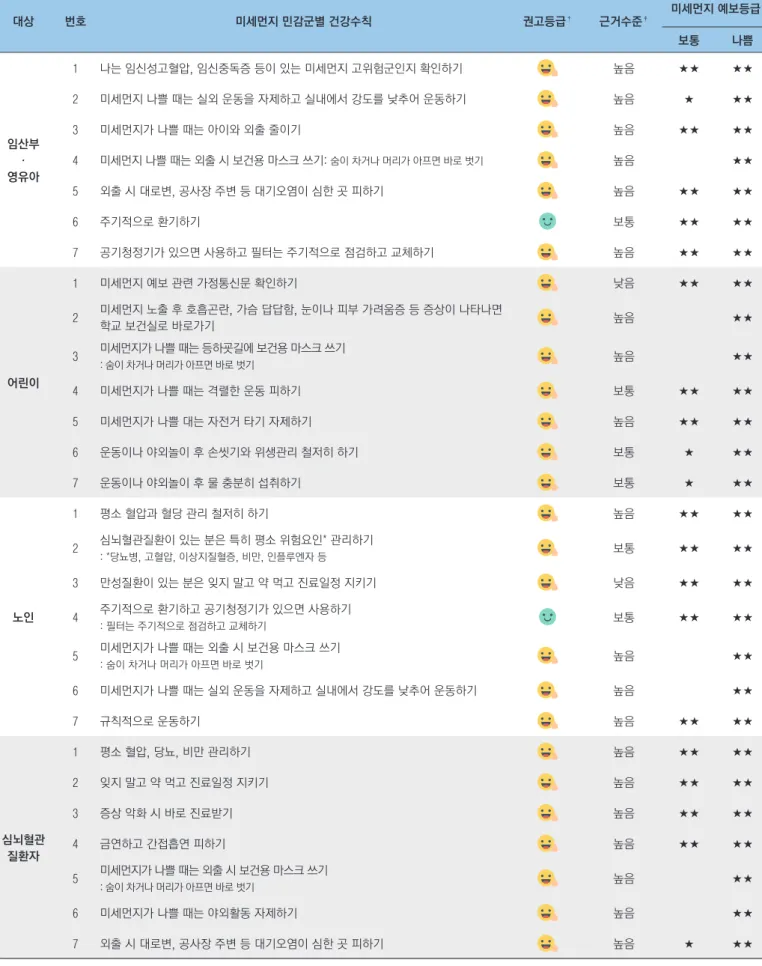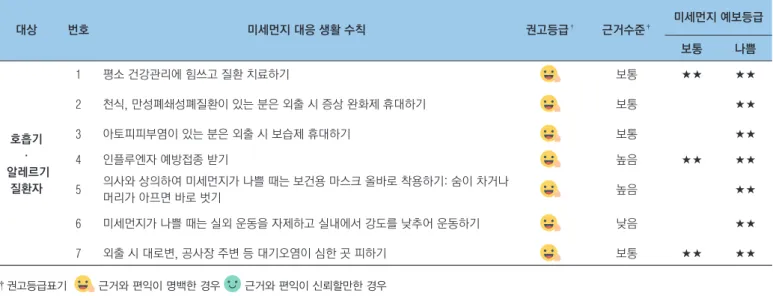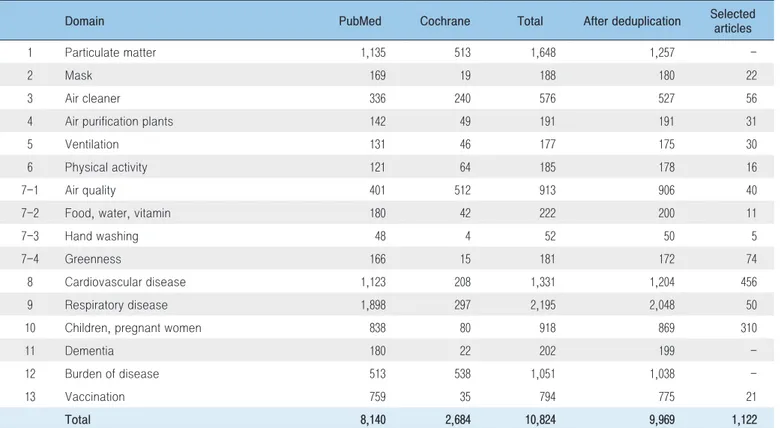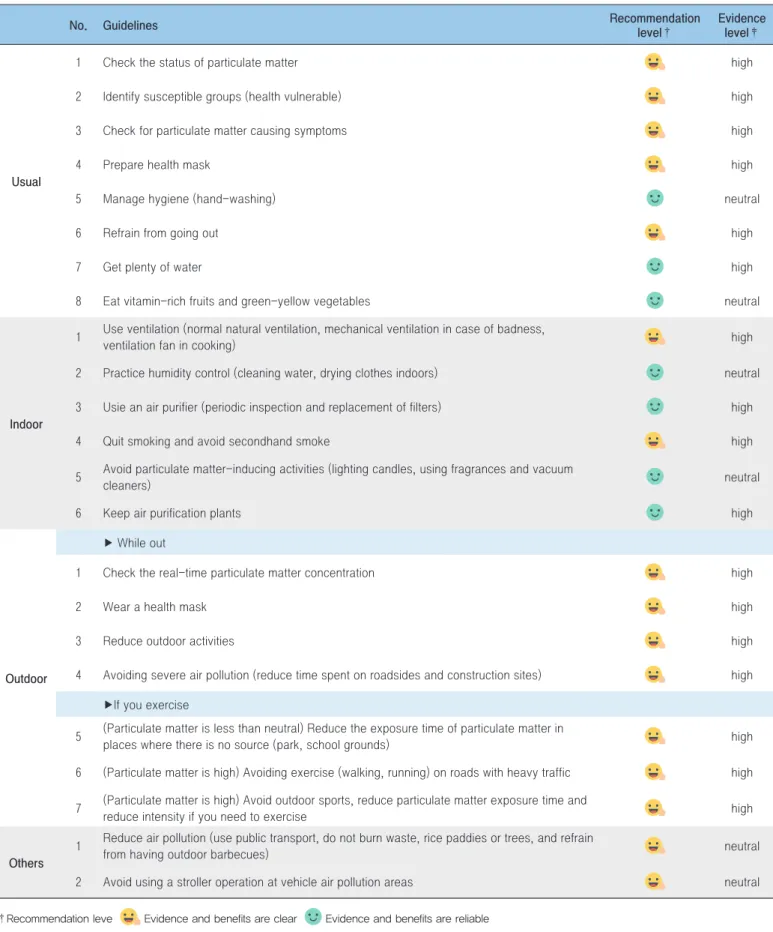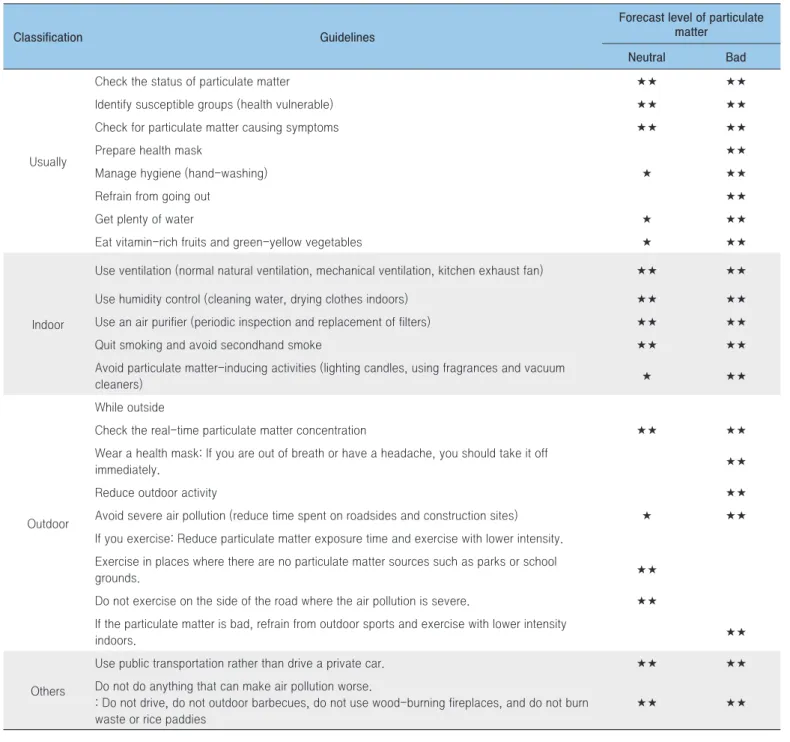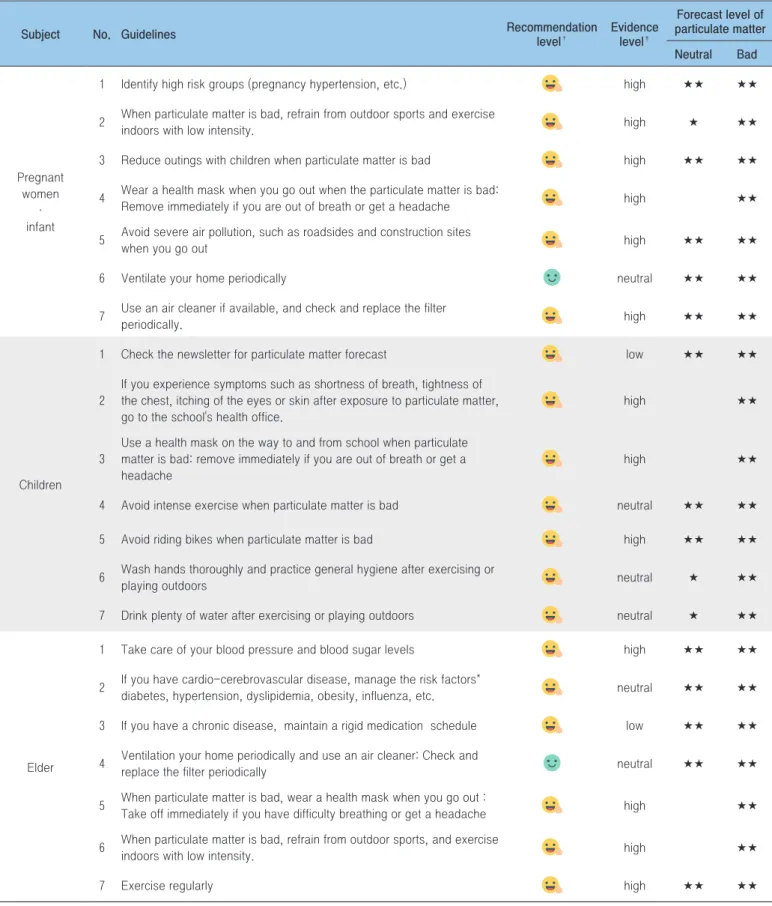근거 기반의 미세먼지 건강수칙 개발
원주세브란스기독병원 직업환경의학과 정경숙 이화여자대학교 의과대학 직업환경의학교실 하은희 대한의학회 신인순 고려대학교 안산병원 직업환경의학과 곽경민 성균관대학교 의과대학 사회의학교실 김종헌, 정해관 *교신저자 : hkcheong75@gmail.com, 031-299-6300 기후변화 및 인접 국가의 영향 등으로 국내의 미세먼지는 점점 심해지고 있으며 2019년 3월에는 미세먼지를 국가 재난으로 선포하게 되었다. 국민들은 미세먼지에 대한 관심과 우려가 커지는 반면 국가에서 제공하는 미세먼지 예보 ‘좋음’, ‘보통’, ‘나쁨’, ‘매우 나쁨’에 따라 어떻게 예방적 행동을 해야 하는지 혼돈스러워 하고 있다. 질병관리본부는 노인, 임산부, 어린이, 심뇌혈관질환, 호흡기질환 및 알레르기질환 등 미세먼지 민감집단에 대해 근거에 기반한 건강정보를 전달하기 위해 대한의학회를 통해 일반인 및 전문가를 위한 건강수칙과 해설본을 개발하였다. 건강수칙 개발 연구팀은 체계적 문헌고찰을 통해 문헌조사를 실시하였고 각각의 권고사항들과 권고사항들에 대한 근거들을 정리하였다. 이 권고사항들은 전문가 델파이 조사를 통해 최종 확정하였고 본 원고에서는 건강수칙 개발 과정을 소개하고자 한다. 주요 검색어 : 미세먼지, 건강영향, 미세먼지 민감군, 건강수칙초 록
들어가는 말
대기오염은 소득 수준, 거주지의 형태, 학력 수준과는 상관없이
모든 사람에게 영향을 미치고 있는 환경 노출로 주요한 건강
문제이다. 세계보건기구(World Health Organization, WHO)는 2016년
대기오염으로 인하여 전 세계에서 약 420만 명이 조기 사망한
것으로 추정한 바 있으며, 전 세계 인구의 91%가 WHO의 대기 질
가이드라인 수준을 충족시키지 못하는 곳에 살고 있다고 하였다[1].
이러한 대기오염 노출에 대비하기 위해 WHO는 2005년 WHO
대기 질 가이드라인(WHO Air quality guidelines)을 제시하였고[2],
2013년에는 대기오염의 건강 측면에 관한 증거 검토(Review of
evidence on health aspects of air pollution)를 제시한 바 있다[3].
우 리 나 라 에 서 는 대 기 오 염 수 준 을 환 경 정 책 기 본 법 ,
대기 환 경 보전법 등 을 적 용 하 여 관 리하고 있다. 우 리나 라
미세먼지(PM10)는 서울의 경우 2002년에는 연평균 76μg/㎥,
2017년에는 44μg/㎥로 감소추세를 보이지만, 미세먼지 주의보 발령
횟수 및 일수가 2010년 1회 3일에서 2017년 6회 10일로 증가하면서
미세먼지에 대한 국민의 관심이 급격히 높아지고 있다[4].
우리나라에서는 연간 약 15,0 0 0~17,0 0 0명의 사람이
대기오염으로 인해 급성 하기도 감염, 폐암, 허혈성심질환, 뇌졸중,
만성폐쇄성폐질환 등으로 조기 사망한 것으로 건강피해가 산출된 바
있다[5,6].
이러한 미세먼지로 인한 국민의 건강피해를 최소화하기
위해 구체적인 건강수칙을 국민에게 제공할 필요가 있다. 이에
일반인구 집단 및 민감집단의 미세먼지에 의한 건강 영향 을
최소화하기 위해 과학적 근거에 기반한 건강수칙을 마련하였다.
몸 말
1. 연구방법
가. 미세먼지 건강수칙 자료 수집
자료 수집을 위해 인터넷과 도서관의 국내외 미세먼지에 의한
건강영향 예방을 위한 건강수칙 자료와 서적들을 찾아보았다. 국내
자료로는 서울시 미세먼지 정보센터, 환경부 미세먼지 팩트 체크,
질병관리본부와 대한의사협회가 공동 개발한 미세먼지의 건강
영향과 환자지도가 있었다. 국외 자료는 영국 공중보건국(Public
Health England)과 왕립 소아과 및 어린이건강학회(Royal College
of Paediatrics and Child Health)의 대기오염 건강영향 교육자료,
대기오염의 건강영향에 대한 위원회(Committee on the Medical
Effects of Air Pollutants, COMEAP)의 대기오염과 심혈관계질환에
대한 영향 및 증거 보고서, 국립보건원(National Institute for Health
and Care Excellence)의 대기오염과 관련하여 걷기와 자전거 타기에
대한 가이드라인, 캐나다 정부의 대기오염에 대한 질의와 응답 등의
자료를 수집하였다.
국내 서적은 미세먼지에 관한 거의 모든 것(김동식, 반기성),
공기 파는 사회에 반대한다(장재연), 의사들이 들려주는 미세먼지와
건강이야기(대한직업환경의학회), 담배보다 해로운 미세먼지(홍동주),
은밀한 살인자 초미세먼지(이노우에 히로요시 저/배영진 역),
미세먼지 극복하기(김동식, 반기성) 등을 검토하였다.
국외 서적은 Pediatric Environmental Health 4
thEdition
(American Academy of Pediatrics), Clinical Environmental
Medicine (Crinnion WJ, Pizzorno JE), Environmental Policy and
Public Health (Rom WN), Environmental Health Literacy (Finn S,
수칙 도출 및 합의 단계
• 국내 · 외 기 개발 수칙 취합 • 수칙별 근거 문헌 검토 · 선정 • 근거수준, 권고 수준 표기 • 합의 기준 도출 • 9점 척도 델파이 조사표 개발 • 온라인 델파이 조사 수행(2 라운드 기획) • 수칙 합의, 수정 및 보완 • 수칙 개발 원칙 적용 • 근거(참고문헌) 선별 · 표기 • 요약정보 리플릿(일반인용, 전문가용) • 소책자 집필(공통수칙, 5개 민감군별) • 결과물에 대한 만족도, 필요도, 활용도 조사 • 전반적인 의견조사 • (필요할 경우) 의견 반영수칙 초안 도출
수칙 합의
결과물 개발
만족도 조사
• 연구진/사업단 • 질환별 소위원회 • 연구진/사업단 • 영역별 전문가 집필 배정 • 대한의학회 개원의 패널(593명) • (필요할 경우) 일반인, 환자 • 전문가 위원회 (대한의학회 미세먼지 특별위원회, 40명)그림 1. 미세먼지 건강영향 예방을 위한 건강수칙 개발과정
표 1. 국내 데이터베이스별 선별문헌 수
Database 계 중복제거 후 선별문헌 1 KoreaMed 175 1.064 216 2 Kmbase 462 3 RISS 790 4 NDSL 91O’Fallon LR Editors), Environmental policy and public health 2
ndedition (Johnson BL, Lichtveld MY), Environmental cardiology
pollution and heart disease (Bhatnagar A), Clinical handbook of
air pollution related disease (Capello F, Gaddi AV), Air pollution
and health effect (Nadadur S, Hollingsworth JW), Fundamental of
air pollution (Vallero D), Introduction to air pollution science (Phalen
RF, Phalen RN)를 참고하였다.
나. 문헌검토
미세먼지 건강수칙에 대한 자료 수집 결과를 바탕으로 체계적
문헌고찰을 실시하였다. 문헌들은 미세먼지, 미세먼지에 대한 중재,
민감집단, 질병부담, 예방접종 등으로 구분하였고, 민감집단은
임산부, 어린이, 노인, 심혈관계 질환자, 호흡기 및 알레르기
질환자를 포함하였다. 이러한 기준으로 ①미세먼지, ②마스크,
③공기청정기, ④공기정화식물, ⑤환기, ⑥신체활동, ⑦공기 질
관리, ⑧심혈관계질환, ⑨호흡기 및 알레르기질환, ⑩어린이·임산부
건강, ⑪노인 건강, ⑫미세먼지와 질병부담/건강영향/건강피해,
미세먼지와 예방/건강수칙/체크리스트/가이드, ⑬미세먼지와
예방접종/자가관리/모니터링/순응도의 13개 영역으로 분류하였다. 이
13개 영역에 대해 영역별로 검색어를 한글과 영어로 정한 후, 최근
10년(2010∼2019년)간 자료를 국외는 PubMed, Cochrane, 국내는
KoreaMed, Kmbase, RISS, NDSL 데이터베이스에서 검색하였다.
검색된 문헌에 대해 EndNote를 통해 연구자들이 선별작업을
수행하였다.
다. 전문가 위원회
전문가 위원회는 대한의학회 산하 186개 전문단체의 추천을
받아 미세먼지 특별위원회
1)와 민감군별 소위원회
2)를 구성하였다.
미세먼지 특별위원회는 수칙 초안 확정용 델파이 조사를 수행하고
민감군별 소위원회는 수칙 초안에 대해 검토하여, 전문가 합의안을
도출하였다.
라. 건강수칙 개발
미세먼지에 의한 건강영향을 예방하기 위한 건강수칙은 국내외
건강수칙 자료를 기본으로 문헌검토를 통해 근거를 찾아 수칙을
개발하고, 각 수칙별로 근거 및 권고 수준을 표기하고, 전문가
위원회의 델파이 조사를 통해 수칙을 수정·보완하고 합의하여
수칙을 확정한 후 각 수칙의 근거에 대한 설명 자료로 소책자를
개발하였다. 건강수칙은 기본 공통수칙 및 민감군별로 일반인용과
전문가용으로 구분하여 개발하였다(그림 1).
2. 연구결과
가. 문헌검색 결과
미세먼지 영역별 검색어(부 록 참조)로 검색하 여 국내
데이터베이스에서는 1,0 6 4 개의 문헌이 검색되었고 검색된
논문의 초록을 검토한 결과 선별된 문헌은 216개이었다. 국외
1) 대한의학회에서 산하의 각 학회에 추천을 받아 구성한 미세먼지 전문가 위원회. 2) 미세먼지 특별위원 중에서 추천 받거나 관련 학회의 추천을 받아 어린이·임산부, 노인, 심뇌혈관, 호흡기, 알레르기 분야의 소위원회를 구성함.데이터베이스에서는 9,969개의 논문이 검색되었고 그 중 1,122개가
선별되었다(표 1, 표 2).
나. 미세먼지 건강영향을 예방하기 위한 건강수칙
수칙 초안 작성 후 문헌검토 결과를 바탕으로 수칙을 평상
시, 실내 공기 질 관리, 실외 활동 시 및 기타로 분류하였고, 각
분류별로 수칙과 각 수칙의 권고등급과 근거수준을 표시하였다(표
3). 대한의학회 미세먼지 특별위원회와 민감군별 미세먼지 전문가
위원회를 이용한 3차례의 델파이 조사에서 전체 42명 중 25명이
응답하여 응답률은 59.5%이었다. 각 수칙에 대해 동의하는 정도를
1~9점 척도(점수가 높을수록 동의하는 정도가 강함)로 조사하였고,
7~9점인 동의율은 평상 시의 건강수칙의 경우 물 충 분히
섭취하기와 비타민이 풍부한 과일 및 녹황색 채소 섭취하기가 각각
52%와 64%로 낮았으며 나머지는 모두 70% 이상이었다. 물 충분히
섭취하기는 근거와 편익이 명백하지는 않지만 전문가 합의로 수칙에
포함하였고, 실내 공기 질 관리는 습도 조절이 근거수준이 높지
않지만 습도가 높을수록 미세먼지 농도가 낮았으며 특히 물청소의
경우 다른 청소방법에 비해 실내에서 먼지 농도를 감소시키는데
효과적이라서 수칙에 포함하였다. 공기정화 식물 키우기는 일부
미세먼지를 저감시켰다는 실험 논문들이 있었으나 공기정화식물이
실내에서 차지하는 비율이 상당히 높아야 하고 델파이 조사에서
동의율이 56.0%로 낮아 최종 수칙에서는 제외하였다. 실외 수칙과
기타는 델파이 조사에서 모두 80% 이상이었다.
전문가 델파이 조사 결과를 바탕으로 연구진 회의를 통해
공기정화식물 키우기와 유모차 운용 자제하기는 삭제하였고, 개원의
패널조사를 통해 각 분류별 최종 미세먼지 대응 기본 생활 수칙과
미세먼지 예보 등급별 전문가 권고 강도는 표 4와 같다.
미세먼지에 대한 기본 건강수칙과 동일한 방법으로 민감집단인
임산부·영유아, 어린이, 노인과 심뇌혈관질환자, 호흡기·알레르기
질환자에 대한 건강수칙의 권고등급, 근거수준 및 전문가 권고
강도를 표 5와 같이 도출하였다.
표 2. 국외 영역별 데이터베이스별 선별문헌 수
영역별 PubMed Cochrane 계 중복 제거 후 선별문헌 1 미세먼지 1,135 513 1,648 1,257 -2 마스크 169 19 188 180 22 3 공기청정기 336 240 576 527 56 4 공기정화식물 142 49 191 191 31 5 환기 131 46 177 175 30 6 신체활동 121 64 185 178 16 7-1 공기 질 관리 등 401 512 913 906 40 7-2 음식, 물, 비타민 180 42 222 200 11 7-3 손 씻기 48 4 52 50 5 7-4 숲 조성 166 15 181 172 74 8 심혈관계질환 1,123 208 1,331 1,204 456 9 호흡기알레르기질환 1,898 297 2,195 2,048 50 10 어린이, 임산부 838 80 918 869 310 11 치매(노인건강) 180 22 202 199 -12 질병부담 등 513 538 1,051 1,038 -13 예방접종 등 759 35 794 775 21 합계 8,140 2,684 10,824 9,969 1,122표 3. 미세먼지 대응 건강수칙 권고등급 및 근거수준
번호 수칙 항목 권고등급† 근거수준‡ 평상 시 1 미세먼지 예보현황 확인하기 높음 2 민감군(건강 취약자) 확인하기 높음 3 미세먼지 유발증상 확인하기 높음 4 보건용 마스크3) 준비하기 높음 5 위생 관리하기(손 씻기) 보통 6 외출(야외활동) 자제하기 높음 7 물 충분히 섭취하기 높음 8 비타민이 풍부한 과일 및 녹황색 야채 섭취하기 보통 실내 공기 질 관리 1 환기(평상시 자연환기, 나쁨일 때 기계 환기, 조리시 환풍기) 높음 2 습도조절(물청소, 실내에서 빨래 말리기) 보통 3 공기청정기 사용하기(공기 청정기 필터 주기적 점검·교체) 높음 4 실내 금연 및 간접흡연 피하기 높음 5 미세먼지 유발행위 자제(촛불 켜기, 방향제, 진공청소기 사용) 보통 6 공기정화식물 키우기 높음 실외 활동 시 ▶ 외출동안 1 실시간 미세먼지 농도 현황 확인하기 높음 2 보건용 마스크 쓰기 높음 3 실외 활동량 줄이기 높음 4 대기오염 심한 곳 피하기(대로변, 공사장 지체시간 줄이기) 높음 ▶운동을 할 경우 5 (미세먼지 보통 이하) 배출원이 없는 장소(공원, 학교 운동장)에서 미세먼지 노출시간 줄이고 강도 낮추어 운동하기 높음 6 (미세먼지 보통 이하) 차량 대기 오염 심한 대로변에서 운동(걷기, 뛰기) 자제하기 높음 7 (미세먼지 높음) 실외 운동 자제하기, 운동을 해야 할 경우 미세먼지 노출시간 줄이고 강도 낮추기 높음 기타 1 대기오염 유발행위 자제하기(대중교통 이용, 폐기물/논두렁/나무 태우기, 야외 바비큐 자제) 보통 2 유모차 운용 자제하기(차량 대기오염 심한 대로변) 보통 †권고등급표기 근거와 편익이 명백한 경우 근거와 편익이 신뢰할만한 경우 ‡근거수준표기 •높음: 수칙 도출의 근거가 명백한 경우(1개 이상의 무작위임상연구(RCT) 혹은 체계적 문헌고찰(SR or meta-analysis)•보통: 수칙 도출의 근거가 명백한 경우(1개 이상의 비 무작위임상연구(non-RCT), 코호트 or 환자-대조군 연구(cohort or case-control study)
3) 입자차단 성능이 있어서 입자성 유해물질이나 감염원으로부터 호흡기를 보호할 목적으로 일상생활에서 필요한 경우에 사용하는 마스크를 의미함. KF(Korea Filter) 값에 따라서 KF80, KF94, KF99 등급이 있으며, 입자차단 성능이 각각 80%, 94%, 99%인 것으로 수치가 높을수록 입자성 유해물질을 더 많이 걸러줌.
표 4. 미세먼지 기본 건강수칙 및 전문가 권고 강도
전문가 권고 강도: ★ 약함 ★★ 강함 분류 미세먼지 기본 건강수칙 미세먼지 예보등급 보통 나쁨 평상 시 평소 미세먼지 예보를 확인하세요. ★★ ★★ 나는 미세먼지 민감군*인지 확인하세요. * 임산부·영유아, 어린이, 노인, 심뇌혈관질환자, 호흡기·알레르기질환자 등 ★★ ★★ 미세먼지 노출 후 나타나는 증상*을 확인하세요. * 호흡 곤란, 가슴 답답함, 눈이나 피부 자극증상, 기침 등 ★★ ★★ 보건용 마스크를 준비하세요. ★★ 손씻기와 위생관리를 철저히 하세요. ★ ★★ 미세먼지가 나쁠 때는 야외활동을 줄이세요. ★★ 물을 충분히 섭취하세요. ★ ★★ 비타민과 항산화제가 풍부한 과일과 채소를 드세요. ★ ★★ 실내 공기 질 관리 주기적으로 환기하세요. ★★ ★★ 주기적으로 물걸레질을 하고 실내 습도를 적절하게 조절하세요. ★★ ★★ 공기청정기가 있으면 사용하고 필터는 주기적으로 점검하고 교체하세요. ★★ ★★ 금연하고 간접흡연을 피하세요. ★★ ★★ 미세먼지를 발생시키지 않도록 하세요. : 촛불 켜기, 향 피우기, 방향제 사용 등을 자제하세요. ★ ★★ 실외 건강수칙 ▶ 외출동안 외출 전 미세먼지 예보를 확인하여 활동계획을 세우세요. ★★ ★★ 미세먼지가 나쁠 때는 외출 시 보건용 마스크를 쓰세요. : 숨이 차거나 머리가 아프면 바로 벗어야 합니다 ★★ 미세먼지가 나쁠 때는 실외 활동량을 줄이세요. ★★ 외출 시 대로변, 공사장 주변 등 대기오염이 심한 곳은 피하세요. ★ ★★ ▶ 운동을 할 경우: 미세먼지 노출 시간을 줄이고 강도를 낮추어 운동하세요. 공원, 학교운동장 등 미세먼지 배출원이 없는 장소에서 운동하세요. ★★ 차량 대기오염이 심한 대로변에서 운동을 자제하세요. ★★ ★★ 미세먼지가 나쁠 때는 실외 운동을 자제하고 실내에서 강도를 낮추어 운동하세요. ★★ 기타 자가용보다 대중교통을 이용하세요. ★★ ★★ 대기오염을 악화시킬 수 있는 행위를 자제하세요. : 자가용운행, 야외 바비큐, 화목난로 사용, 폐기물 및 논두렁 태우기 등 ★★ ★★표 5. 미세먼지 민감군별 건강수칙 및 근거수준, 전문가 권고 강도
전문가 권고 강도: ★ 약함 ★★ 강함 대상 번호 미세먼지 민감군별 건강수칙 권고등급† 근거수준‡ 미세먼지 예보등급 보통 나쁨 임산부 · 영유아 1 나는 임신성고혈압, 임신중독증 등이 있는 미세먼지 고위험군인지 확인하기 높음 ★★ ★★ 2 미세먼지 나쁠 때는 실외 운동을 자제하고 실내에서 강도를 낮추어 운동하기 높음 ★ ★★ 3 미세먼지가 나쁠 때는 아이와 외출 줄이기 높음 ★★ ★★ 4 미세먼지 나쁠 때는 외출 시 보건용 마스크 쓰기: 숨이 차거나 머리가 아프면 바로 벗기 높음 ★★ 5 외출 시 대로변, 공사장 주변 등 대기오염이 심한 곳 피하기 높음 ★★ ★★ 6 주기적으로 환기하기 보통 ★★ ★★ 7 공기청정기가 있으면 사용하고 필터는 주기적으로 점검하고 교체하기 높음 ★★ ★★ 어린이 1 미세먼지 예보 관련 가정통신문 확인하기 낮음 ★★ ★★ 2 미세먼지 노출 후 호흡곤란, 가슴 답답함, 눈이나 피부 가려움증 등 증상이 나타나면 학교 보건실로 바로가기 높음 ★★ 3 미세먼지가 나쁠 때는 등하굣길에 보건용 마스크 쓰기 : 숨이 차거나 머리가 아프면 바로 벗기 높음 ★★ 4 미세먼지가 나쁠 때는 격렬한 운동 피하기 보통 ★★ ★★ 5 미세먼지가 나쁠 대는 자전거 타기 자제하기 높음 ★★ ★★ 6 운동이나 야외놀이 후 손씻기와 위생관리 철저히 하기 보통 ★ ★★ 7 운동이나 야외놀이 후 물 충분히 섭취하기 보통 ★ ★★ 노인 1 평소 혈압과 혈당 관리 철저히 하기 높음 ★★ ★★ 2 심뇌혈관질환이 있는 분은 특히 평소 위험요인* 관리하기 : *당뇨병, 고혈압, 이상지질혈증, 비만, 인플루엔자 등 보통 ★★ ★★ 3 만성질환이 있는 분은 잊지 말고 약 먹고 진료일정 지키기 낮음 ★★ ★★ 4 주기적으로 환기하고 공기청정기가 있으면 사용하기 : 필터는 주기적으로 점검하고 교체하기 보통 ★★ ★★ 5 미세먼지가 나쁠 때는 외출 시 보건용 마스크 쓰기 : 숨이 차거나 머리가 아프면 바로 벗기 높음 ★★ 6 미세먼지가 나쁠 때는 실외 운동을 자제하고 실내에서 강도를 낮추어 운동하기 높음 ★★ 7 규칙적으로 운동하기 높음 ★★ ★★ 심뇌혈관 질환자 1 평소 혈압, 당뇨, 비만 관리하기 높음 ★★ ★★ 2 잊지 말고 약 먹고 진료일정 지키기 높음 ★★ ★★ 3 증상 악화 시 바로 진료받기 높음 ★★ ★★ 4 금연하고 간접흡연 피하기 높음 ★★ ★★ 5 미세먼지가 나쁠 때는 외출 시 보건용 마스크 쓰기 : 숨이 차거나 머리가 아프면 바로 벗기 높음 ★★ 6 미세먼지가 나쁠 때는 야외활동 자제하기 높음 ★★ 7 외출 시 대로변, 공사장 주변 등 대기오염이 심한 곳 피하기 높음 ★ ★★맺는 말
미세먼지를 포함한 대기오염의 건강영향에 대한 국민적
관 심 사 와 요구 에 부 응하 여 질병관 리본 부 와 대한의학 회의
전문성을 바탕으로 체계적이고 과학적인 과정을 거쳐 근거기반의
국민행동수칙과 의료인에 대한 교육 자료를 개발하였다.
이 연구는 우리나라에서 처음으로 미세먼지 영역에서 지난
10년 동안의 국내외 근거를 체계적으로 검색ㆍ선별하였고, 근거를
기반으로 미세먼지 건강수칙을 도출하였다. 그러나 제시한 수칙들이
현실적으로 국민들이 공감할 수 있는 수칙인가에 대해서는 향후
국민 의견을 수렴하여 지속적으로 보완해 나갈 필요가 있다.
그리고 미세먼지 대응과 관련해서 국민들의 현실적인 궁금증을
취합하여 가이드를 제시하고, 실질적으로 도움을 줄 수 있는
방향으로 미세먼지 건강수칙 가이드 및 질의응답 콘텐츠를 개정해
나갈 필요가 있다. 즉, 국민들과 민감집단의 다양한 상황과 질문을
고려하여 보다 상황에 맞는 맞춤형 수칙을 개발할 필요가 있다.
기존 연구에서는 미세먼지 노출 수준이 우리나라에 비해 높지 않은
환경이었고, 각 미세먼지 수준에서 어떻게 행동해야 하는지에 대한
역치를 찾을 수 있는 연구는 거의 없어 수칙을 제안하는데 제한점이
있었다. 또한, 미세먼지 관련된 모든 건강영향을 수용하기 어려웠던
점이 있어 향후 건강영향 영역을 추가할 필요가 있다.
이 연구 결과가 미세먼지에 대한 국민들의 과도한 불안을
줄이고 적절하게 대응할 수 있으며 일상생활 속에서 미세먼지의
저감 행동
4)을 유도하는 역할을 수행할 것을 기대한다. 향후 유사한
문제에 대한 정부와 전문가 단체의 적극적 대응의 좋은 본보기로
작용할 것을 기대한다.
4) 미세먼지를 줄이는 행동. 예를 들면 자가용보다는 대중교통을 이용하고, 야외 바비큐, 화목난로 사용이나, 폐기물 및 논두렁 태우기와 같은 미세먼지를 발생시키는 행위 등을 하지 않는 것. 대상 번호 미세먼지 대응 생활 수칙 권고등급† 근거수준‡ 미세먼지 예보등급 보통 나쁨 호흡기 · 알레르기 질환자 1 평소 건강관리에 힘쓰고 질환 치료하기 보통 ★★ ★★ 2 천식, 만성폐쇄성폐질환이 있는 분은 외출 시 증상 완화제 휴대하기 보통 ★★ 3 아토피피부염이 있는 분은 외출 시 보습제 휴대하기 보통 ★★ 4 인플루엔자 예방접종 받기 높음 ★★ ★★ 5 의사와 상의하여 미세먼지가 나쁠 때는 보건용 마스크 올바로 착용하기: 숨이 차거나 머리가 아프면 바로 벗기 높음 ★★ 6 미세먼지가 나쁠 때는 실외 운동을 자제하고 실내에서 강도를 낮추어 운동하기 낮음 ★★ 7 외출 시 대로변, 공사장 주변 등 대기오염이 심한 곳 피하기 보통 ★★ ★★ †권고등급표기 근거와 편익이 명백한 경우 근거와 편익이 신뢰할만한 경우 ‡근거수준표기 •높음: 수칙 도출의 근거가 명백한 경우 (1개 이상의 무작위임상연구 (RCT) 혹은 체계적 문헌고찰 (SR or Meta-analysis)•보통: 수칙 도출의 근거가 명백한 경우 (1개 이상의 비 무작위임상연구 (non-RCT), 코호트 or 환자-대조군 연구 (Cohort Case-control) •낮음: 수칙 도출의 근거가 있으나 신뢰할 수 없는 경우 혹은 근거가 불충분한 경우 관찰연구, 증례보고, 전문가 의견 (Expert opinion) 전문가 권고강도: ★ 약함 ★★ 강함
① 이전에 알려진 내용은?
기존 연구에서는 미세먼지 노출 수준이 우리나라에 비해
높지 않은 환경이었고, 각 미세먼지 수준에서 어떻게 행동해야
하 는지에 대한 역치를 찾을 수 있는 연구는 거의 없어
국민들에게 건강수칙을 제안하는데 제한점이 있었다.
② 새로이 알게 된 내용은?
국내 최초로 전문가들이 합의하여 일반인과 전문가가 활용할
수 있는 미세먼지 건강수칙을 개발하였다. 개발을 위해 국내외
총 1,338편(국내 데이터베이스로부터 선정한 문헌 216건, 국외
데이터베이스로부터 선정한 문헌 1,122건) 논문과 참고문헌을
정리하였다.
③ 시사점은?
본 연구를 통해 미세먼지에 대한 국민들의 과도한 불안을
줄이고 적절하게 대응할 수 있으며 일상생활 속에서 미세먼지의
저감 행동을 유도하는 역할을 수행할 것을 기대한다.
참고문헌
1. WHO. Ambient air pollution. 2018. available at https://www.who.int/ news-room/fact-sheets/detail/ ambient-(outdoor)-air-quality-and-health
2. WHO. WHO Air quality guidelines for particulate matter, ozone, nitrogen dioxide and sulfur dioxide. 2005.
3. WHO. Review of evidence on health aspects of air pollution-REVIHAPP Project. 2013.
4. 서울시. 서울특별시 대기환경정보 대기통계. http://cleanair.seoul.go.kr/ air_pollution.htm?method=average
5. Kim JH, et al. Premature Deaths Attributable to Long-term Exposure to Ambient Fine Particulate Matter in the Republic of Korea. J Korean Med Assoc 2018;33(37):e251.
6. Han C et al. Spatial and temporal trends of number of deaths attributable to ambient PM(2.5) in the Korea. J Korean Med Sci 2018;33:e193.
※ 이 글은 질병관리본부 미래질병대비과에서 발주한 정책연구 용역사업 「질환별 미세먼지 대비 건강수칙 및 의료인용 표준교육자료 개발(2019P140100)」을 통해 수행한 최종 연구결과의 주요 내용을 요약·정리하였습니다.
부록. 미세먼지 영역별 검색 키워드
대분류 키워드_한글 키워드_영문 1. 미세먼지 미세먼지 particulate matter 대기오염 air pollution 2. 마스크 마스크 mask 3. 공기청정기 헤파필터 HEPA filter공기청정기 air cleaner, air purifier 4. 공기정화식물 공기정화 식물 air purification plants 5. 환기 환기 ventilation 환기 장치 ventilator 자연 환기 natural ventilation 6. 신체활동 신체활동 physical activity 실외활동 outdoor activity 실내활동 indoor activity 학교활동 school activity 자전거 타기 cycling, bicycle riding 7. 공기 질 (관리):
3~4개로 구분 필요함
실내공기 질 indoor air quality 실외공기 질 ambient air quality 흡연, 간접흡연 smoking
습도 humidity
도로변 통행 traffic volume, traffic-related emission, traffic emission, traffic pollutant 조리연료 cooking fuel, cook stove
비타민 vitamin 녹황색 채소 green vegetables 물 마시기 drinking water 미세먼지 배출 음식 미세먼지 묻은 음식 손 씻기 hand washing 옷 세탁 숲 조성 효과 greenness
8. 심혈관계질환 (포함 질환명임)
심혈관질환 cardiovascular disease 심혈관 건강 Cardiovascular Health 관상동맥질환 coronary artery disease 동맥경화증 atherosclerosis 협심증 ischemic heart disease 심근경색 myocaridial infaction 부정맥 arrhythmia 혈압 blood pressure 고혈압 hypertension 심전도 electrocardiogram 뇌경색 cerebral infarction 뇌졸중 stroke 뇌출혈 cerebral hemorrhage 9. 호흡기 및 알레르기 질환 (포함 질환명임) 호흡기질환 respiratory disease
만성폐쇄성폐질환 chronic obstructive pulmonary disease 폐암 lung cancer
하기도 감염 lower respiratory infection 폐렴 pneumonia 알레르기질환 allergic disease 천식 asthma 알레르기비염 allergic rhinitis 아토피 atopy 아토피 피부염 atopic dermatitis 10. 어린이, 임산부 건강 자폐증 autism spectrum disorder
조기사망 premature death 발육지연 태아 small for gestational age 부정적인 출생의 결과 adverse birth outcome 성장 지연 growth retardation 고혈압 hypertension 사산 stillbirth 유산 abortion 불임 infertility 인지기능 장애 cognitive dysfunction 11. 노인 건강 치매 dementia, Alzheimer's disease
12. 미세먼지와 질병부담(incidence, morbidity, mortality), 미세먼지와 건강 영향 or 건강피해, 미세먼지와 예방 or 건강수칙 or 체크리스트 or 가이드 13. 미세먼지와 예방접종(인플루엔자, 페렴사슬구균), 미세먼지와 자가관리 or 모니터링 or 순응도
Development of Evidence-Based Guidelines to Prevent the Negative Health
Effects of Particulate Matter (PM)
Jeong Kyoung Sook
Department of Occupational and Environmental Medicine, Wonju Severance Christian Hospital Ha Eunhee
Department of Occupational and Environmental Medicine, Ewha Medical Research Center, College of Medicine, Ewha Womans University Shin Ein-Soon
Research Agency for Clinical Practice Guidelines, Korean Academy of Medical Sciences Research Center Kwak Kyeongmin
Department of Occupational and Environmental Medicine, Korea University Ansan Hospital Kim Jong-Hun, Hae-Kwan Cheong
Department of Social and Preventive Medicine, Sungkyunkwan University School of Medicine
There is growing acceptance that climate change, domestic air pollutants and pollutants from neighboring countries caused an increase in particulate matter (PM) in Korea. In March 2019, dangerous microfine particulate matter (PM 2.5) was declared a social disaster. However, this study found that, although the interest and concern for PM prevention increased, the public remained unclear about how to act proactively according to the fine, neutral, bad, and very bad forecasts provided by the government. In response, the Korea Centers for Disease Control and Prevention (KCDC) developed preventive guidelines and recommendations for the general public. Also, the Korean Academy of Medical Sciences (KAMS), the nation's top expert group, provided evidence-based health information for PM susceptible groups such as the elderly, pregnant women, children, and those who have cardio-cerebrovascular, respiratory, and allergic diseases. This study developed preventive guidelines through a systematic review of the literature, summarized the recommendations and provided the rationale behind the recommendations. This study’s recommendations were finalized through an expert Delphi survey and this article introduced the process of developing preventive guidelines.
Steps to derive and agree the guidelines
• Collection of domestic and international guidelines • Article review and selection by guidelines
• Indicate evidence and recommendation level
• Derivation of Consensus Standards • Development of 9-point Delphi survey • Delphi online survey
• Agreement, correction and improvement
• Apply development principles • Evidence selection and mark
• Leaflets (For general people and experts) • Manual (Common, Susceptible group)
• Survey for satisfaction, necessity, and utilization for outcomes
• Survey for general opinions • Reflection of opinion if necessary
Initial draft
Agreement
Outcome
Satisfaction survey
• Researchers • Subcommittee by disease • Researchers • Experts by specialty• Private clinician in KAMS (N=593) • General people and patients if necessary
• Experts committee
(Special Committee of Particulate matter in Korean Academy of Medical Sciences)
Figure 1. Development process of health guidelines to prevent health effects of particulate matter (PM)
Table 1. Selected articles by domestic database
Database Total After deduplication Selected articles 1 Korean Association of Medical Journal Editors (KAMJE) KoreaMed 175
1,064 216 2 Korean Medical Database (KMbase) 462
3 Research Information Sharing Service (RISS) 790 4 National Digital Science Library (NDSL) 91
Table 2. Selected articles by international database
Domain PubMed Cochrane Total After deduplication Selected articles 1 Particulate matter 1,135 513 1,648 1,257 -2 Mask 169 19 188 180 22 3 Air cleaner 336 240 576 527 56 4 Air purification plants 142 49 191 191 31 5 Ventilation 131 46 177 175 30 6 Physical activity 121 64 185 178 16 7-1 Air quality 401 512 913 906 40 7-2 Food, water, vitamin 180 42 222 200 11 7-3 Hand washing 48 4 52 50 5 7-4 Greenness 166 15 181 172 74 8 Cardiovascular disease 1,123 208 1,331 1,204 456 9 Respiratory disease 1,898 297 2,195 2,048 50 10 Children, pregnant women 838 80 918 869 310 11 Dementia 180 22 202 199 -12 Burden of disease 513 538 1,051 1,038 -13 Vaccination 759 35 794 775 21 Total 8,140 2,684 10,824 9,969 1,122
Table 3. Recommendations and evidence level of guidelines to prevent the negative health effects of particulate matter (PM)
No. Guidelines Recommendation level† Evidence level‡
Usual
1 Check the status of particulate matter high 2 Identify susceptible groups (health vulnerable) high 3 Check for particulate matter causing symptoms high 4 Prepare health mask high 5 Manage hygiene (hand-washing) neutral 6 Refrain from going out high 7 Get plenty of water high 8 Eat vitamin-rich fruits and green-yellow vegetables neutral
Indoor
1 Use ventilation (normal natural ventilation, mechanical ventilation in case of badness,
ventilation fan in cooking) high 2 Practice humidity control (cleaning water, drying clothes indoors) neutral 3 Usie an air purifier (periodic inspection and replacement of filters) high 4 Quit smoking and avoid secondhand smoke high 5 Avoid particulate matter-inducing activities (lighting candles, using fragrances and vacuum
cleaners) neutral 6 Keep air purification plants high
Outdoor
▶ While out
1 Check the real-time particulate matter concentration high 2 Wear a health mask high 3 Reduce outdoor activities high 4 Avoiding severe air pollution (reduce time spent on roadsides and construction sites) high
▶If you exercise
5 (Particulate matter is less than neutral) Reduce the exposure time of particulate matter in
places where there is no source (park, school grounds) high 6 (Particulate matter is high) Avoiding exercise (walking, running) on roads with heavy traffic high 7 (Particulate matter is high) Avoid outdoor sports, reduce particulate matter exposure time and
reduce intensity if you need to exercise high Others
1 Reduce air pollution (use public transport, do not burn waste, rice paddies or trees, and refrain
from having outdoor barbecues) neutral 2 Avoid using a stroller operation at vehicle air pollution areas neutral
†Recommendation leve Evidence and benefits are clear Evidence and benefits are reliable ‡Evidence level
•high: guidelines based on clear evidence (randomized control study or systematic review (SR or meta-analysis) •neutral: guidelines based on clear evidence (non-Randomized control study, cohort or case-control study)
Table 4. Guidelines to prevent the negative health effects of particulate matter (PM) and the recommendation levels of experts
Recommendation strength: ★ weak ★★ strong Classification Guidelines
Forecast level of particulate matter
Neutral Bad
Usually
Check the status of particulate matter ★★ ★★ Identify susceptible groups (health vulnerable) ★★ ★★ Check for particulate matter causing symptoms ★★ ★★ Prepare health mask ★★ Manage hygiene (hand-washing) ★ ★★ Refrain from going out ★★ Get plenty of water ★ ★★ Eat vitamin-rich fruits and green-yellow vegetables ★ ★★
Indoor
Use ventilation (normal natural ventilation, mechanical ventilation, kitchen exhaust fan) ★★ ★★ Use humidity control (cleaning water, drying clothes indoors) ★★ ★★ Use an air purifier (periodic inspection and replacement of filters) ★★ ★★ Quit smoking and avoid secondhand smoke ★★ ★★ Avoid particulate matter-inducing activities (lighting candles, using fragrances and vacuum
cleaners) ★ ★★
Outdoor
While outside
Check the real-time particulate matter concentration ★★ ★★ Wear a health mask: If you are out of breath or have a headache, you should take it off
immediately. ★★ Reduce outdoor activity ★★ Avoid severe air pollution (reduce time spent on roadsides and construction sites) ★ ★★ If you exercise: Reduce particulate matter exposure time and exercise with lower intensity.
Exercise in places where there are no particulate matter sources such as parks or school
grounds. ★★
Do not exercise on the side of the road where the air pollution is severe. ★★ If the particulate matter is bad, refrain from outdoor sports and exercise with lower intensity
indoors. ★★
Others
Use public transportation rather than drive a private car. ★★ ★★ Do not do anything that can make air pollution worse.
: Do not drive, do not outdoor barbecues, do not use wood-burning fireplaces, and do not burn waste or rice paddies
Table 5. Recommendations and evidence level of guidelines to prevent the negative health effects of particulate matter by
susceptible groups
Recommendation strength: ★ weak ★★ strong Subject No. Guidelines Recommendation level†
Evidence level‡ Forecast level of particulate matter Neutral Bad Pregnant women · infant
1 Identify high risk groups (pregnancy hypertension, etc.) high ★★ ★★ 2 When particulate matter is bad, refrain from outdoor sports and exercise
indoors with low intensity. high ★ ★★ 3 Reduce outings with children when particulate matter is bad high ★★ ★★ 4 Wear a health mask when you go out when the particulate matter is bad:
Remove immediately if you are out of breath or get a headache high ★★ 5 Avoid severe air pollution, such as roadsides and construction sites
when you go out high ★★ ★★ 6 Ventilate your home periodically neutral ★★ ★★ 7 Use an air cleaner if available, and check and replace the filter
periodically. high ★★ ★★
Children
1 Check the newsletter for particulate matter forecast low ★★ ★★ 2
If you experience symptoms such as shortness of breath, tightness of the chest, itching of the eyes or skin after exposure to particulate matter, go to the school's health office.
high ★★
3
Use a health mask on the way to and from school when particulate matter is bad: remove immediately if you are out of breath or get a headache
high ★★ 4 Avoid intense exercise when particulate matter is bad neutral ★★ ★★ 5 Avoid riding bikes when particulate matter is bad high ★★ ★★ 6 Wash hands thoroughly and practice general hygiene after exercising or
playing outdoors neutral ★ ★★ 7 Drink plenty of water after exercising or playing outdoors neutral ★ ★★
Elder
1 Take care of your blood pressure and blood sugar levels high ★★ ★★ 2 If you have cardio-cerebrovascular disease, manage the risk factors*
diabetes, hypertension, dyslipidemia, obesity, influenza, etc. neutral ★★ ★★ 3 If you have a chronic disease, maintain a rigid medication schedule low ★★ ★★ 4 Ventilation your home periodically and use an air cleaner: Check and
replace the filter periodically neutral ★★ ★★ 5 When particulate matter is bad, wear a health mask when you go out :
Take off immediately if you have difficulty breathing or get a headache high ★★ 6 When particulate matter is bad, refrain from outdoor sports, and exercise
indoors with low intensity. high ★★ 7 Exercise regularly high ★★ ★★
Recommendation strength: ★ weak ★★ strong Subject No. Guidelines Recommendation level†
Evidence level‡ Forecast level of particulate matter Neutral Bad Cardiocerebral diseases
1 Manage your usual blood pressure, and control diabetes and obesity high ★★ ★★ 2 Remember to maintain a rigid medication schedule high ★★ ★★ 3 See doctor immediately if symptoms worsen high ★★ ★★ 4 Quit smoking and avoid secondhand smoke high ★★ ★★ 5 If particulate matter is bad, use a health mask when you go out: Take off
immediately if you are out of breath or get a headache high ★★ 6 Avoiding outdoor activities when particulate matter is bad high ★★ 7 Avoid severe air pollution, such as roadsides and construction sites when
you go out high ★ ★★
Respiratory· Allergic diseases
1 Work on your health care and treat your illness neutral ★★ ★★ 2 If you have asthma or chronic obstructive pulmonary disease, keep
checking your symptoms when you are out. neutral ★★ 3 If you have atopic dermatitis, take a moisturizer when you go out neutral ★★ 4 Get the influenza vaccine high ★★ ★★ 5 Talk to your doctor and wear a health mask when particulate matter is bad
: If you are out of breath or get a headache; take off immediately high ★★ 6 When particulate matter bad, refrain from outdoor sports, and try to
exercise less intensely indoors. low ★★ 7 Avoid severe air pollution, such as roadsides and construction sites when
you go out neutral ★★ ★★
†Recommendation level Evidence and benefits are clear Evidence and benefits are reliable ‡Evidence level
•high: guidelines based on clear evidence (Randomized control study or systematic review (SR or meta-analysis) •neutral: guidelines based on clear evidence (non-Randomized control study, cohort or case-control study)
•low: There are grounds for deriving the guidelines, but they are unreliable or insufficient such as observational studies, case reports, and expert opinions

